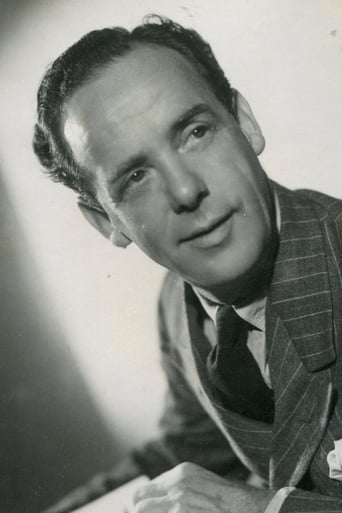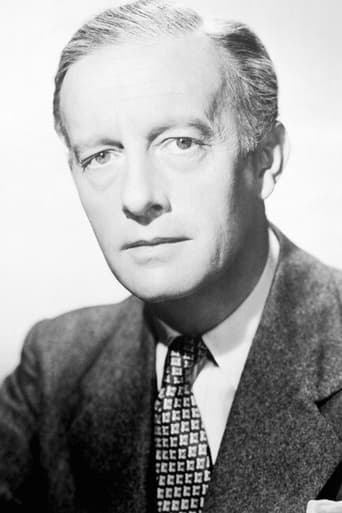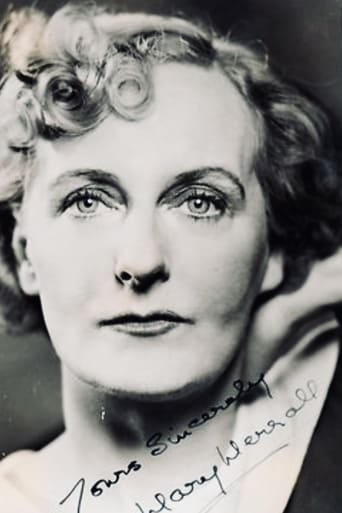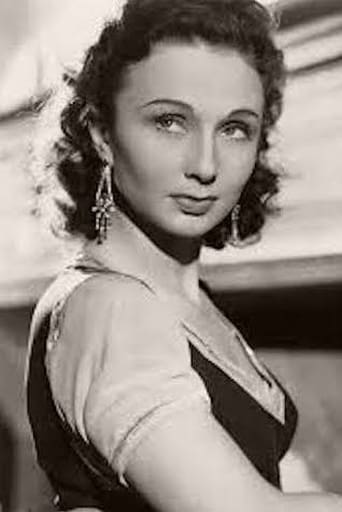Alicia
I love this movie so much
TaryBiggBall
It was OK. I don't see why everyone loves it so much. It wasn't very smart or deep or well-directed.
Bluebell Alcock
Ok... Let's be honest. It cannot be the best movie but is quite enjoyable. The movie has the potential to develop a great plot for future movies
Scarlet
The film never slows down or bores, plunging from one harrowing sequence to the next.
Leofwine_draca
DEAD OF NIGHT is the first horror anthology film and a well-remembered classic courtesy of Ealing Studios. The first story is a short but sweet tale of precognition and a spooky omen. Although it's a simply-told story, the presence of the ever-cheerful Miles Malleson as the chirpy hearse driver certainly enlivens the segment a lot, while the haunted performance from narrator Antony Baird also keeps things interesting. The best thing about this tale, though, is the subtle chill that ensues after Baird realises that the bus is on its way to doom and backs away; both he and the viewer stare on in horror at the inevitable, a climax which isn't ruined by some rather unconvincing model work.The second story is largely disappointing, and any chills are dissipated by the overacting of the youthful cast. The story is of a Christmas party at an old mansion. While playing hide-and-seek, a girl finds herself in a remote attic bedroom where she befriends a frightened young boy. Later on that evening, she discovers that the boy was murdered by his sister decades ago. The figure she was with turns out to be a ghost. Sadly, the female lead in this story is terrible with her clumsy over-emphasising which makes her performance an embarrassing one. The old-fashioned dialogue and plot points also make this one less than inspiring.Thankfully, the third story returns some credibility to the film, with an interesting tale telling of a man haunted by a possessed mirror which witnessed murder and suicide decades before. The man finds himself becoming possessed by the spirit of the murderer and attempts to kill his wife. This is a clever and disturbing tale, with some good, understated acting from the male lead and an imaginative plot. It was reworked in 1973's FROM BEYOND THE GRAVE with David Warner in a more gruesome fashion.The fourth is an incongruous comedy which is at odds with the rest of the subtlety-filled chills and hauntings. It concerns two rival golfing companions who both fall for the same girl. To decide who gets her, the pair embark on a tournament together, with one of the men winning through cheating. His rival promptly walks into a lake and drowns himself, but the winner finds himself haunted by his companion. Although this episode is mildly amusing, the comedy aspects have dated in the worst way and the whole story is treated as one big 'joke'. See AN American WEREWOLF IN London for a better film about a man being haunted by his dead friend.The fifth and final story is a case of saving the best till last. This classic and well-remembered yarn concerns a ventriloquist who becomes possessed by his own dummy. It turns out that he is actually a schizophrenic who personifies his dummy, Hugo, as an evil, living being and who eventually causes him to attempt murder. Thanks to some fantastic acting from a twitchy Michael Redgrave (plus the narrator, a disbelieving doctor) and a really spooky story, this is classic stuff and inspired at least two full-length movies, DEVIL DOLL and MAGIC. There's just something inherently sinister about a wooden dummy's grinning and this intelligent story exploits that to the full.Subtle and spooky, Dead of Night is an effectively chilling ghost film and a minor classic of the genre. While not explicitly frightening today, most of the episodes still pack a punch and the film is well worth watching for the story lines, the performers, and the circular ending.
Maddyclassicfilms
Dead of Night is directed by Basil Dearden, Charles Crichton, Robert Hamer and Alberto Cavalcanti. The film stars Mervyn Johns, Michael Redgrave, Roland Culver, Antony Baird, Sally Ann Howes, Ralph Michael, Googie Withers, Basil Radford and Naunton Wayne.This 1945 British horror anthology film has a very creepy atmosphere and is ideal viewing at night or on a rainy afternoon. The film has the look and feel of an actual nightmare, the sequence just before the end where all the stories become linked in a nightmare is a perfect example of this. Things become mixed up, distorted and terrifying, just as they do when you have a nightmare.Architect Walter Craig(Mervyn Johns)is invited down to the house of a friend with the possibility of getting some work. When he arrives there are a group of people also there for the weekend. Craig is struck by the strangest feeling that he has seen them all before. He then realises that he has had a dream about the house and this group of people and he somehow knows what they will all say and do next.Intrigued and amused by his claims that he can predict what will happen the rest of the group all tell stories of spooky incidents that they themselves have encountered. The film is then split into several segments as these stories are shown to us.Segment one concerns a racing driver(Antony Baird)who is injured in a crash. When he awakens in hospital he is struck by an uneasy feeling that something bad is going to happen. He has a premonition which later saves his life. Segment two concerns a young girl(Sally Ann Howes)who during a game of hide and seek encounters a young boy who is the ghost of a murder victim.Oddly the actor who plays the young boy is uncredited. Segment three concerns a husband and wife (Ralph Michael and Googie Withers)who are driven to the brink of madness by a haunted antique mirror which shows a room from the past. Segment four is the weakest of the stories. It has a great deal of comic content which is odd to include in a horror anthology. Two golfers (Basil Radford and Naunton Wayne)are in love with the same woman and one of them ends up as a ghost. This one strikes me as just an excuse to show Wayne and Radford in a film, these two appear regularly throughout the 1930's and 1940's as comic characters Charter's and Caldicott, their characters in this film might as well just have been those characters.The fifth and most memorable segment concerns a ventriloquist (Michael Redgrave)losing his grip on reality and sanity when he becomes convinced his dummy is actually alive. Redgrave gives one of his best performances as the man losing his mind. The dummy itself is extremely creepy and these sort of stories never lose their ability to freak out the audience.There is a twist at the end which makes the film even more creepy.A must see for fans of The Twilight Zone series and the Amicus horror films, such as Dr.Terror's House of Horrors.
Claudio Carvalho
The architect Walter Craig (Mervyn Johns) drives to a farmhouse in the countryside of London and he is welcomed by the owner, Eliot Foley (Roland Culver), who introduces him the psychiatrist Dr. Van Straaten (Frederick Valk), his friend Joan Cortland (Googie Withers), his young neighbor Sally O'Hara (Sally Ann Howes) and the race car driver Hugh Grainger (Antony Baird). Craig tells that he has the sensation of Déjà vu since he had had a nightmare with them in that house but one lady is missing. However Mrs. Foley (Mary Merrall) arrives completing the characters of his dream.The skeptical Dr. Van Straaten does not believe in supernatural but the guests tell supernatural events that they have lived. Grainger had a car accident and then a premonition that saved his life; Sally had met a ghost during the Christmas; Eliot and his wife had lived an evil experience with a haunted mirror; two golfers that loved the same woman and decide to dispute her in a game, but one of them dies and haunt the other; and Dr. Van Straaten tells the story of a ventriloquist with double personality that is dominated by his dummy. But when Dr. Van Straaten accidentally breaks his classes and the power goes out, the nightmare begins."Dead of Night" is an original horror tale that is certainly the source of inspiration to "The Twilight Zone", "Tales From The Crypt", "Vault of Horror", "Creepshow", "Tales From the Darkside: the Movie" where the screenplay discloses a main story and many segments. The final twist is totally unexpected and a plus in this little great movie. My vote is eight.Title (Brazil): "Na Solidão da Noite" ("In the Solitude of the Night")
TheRedDeath30
This movie definitely holds a good deal of historical significance for a number of reasons. Horror had a golden age at the turn of the century, in both film and literature. While movie studios like Universal were churning out monster movies, there was a flood of British authors churning out high quality horror stories for a number of very successful pulp magazines. All of that came to a stop during WWII when Britain decided its' citizens had enough horror and banned the genre. This movie really was the comeback for British film horror and used several stories from those old pulps as its foundation. It's also, quite arguably, the first horror anthology and sets the standard that would be used in many movies to come over the next 50 plus years.Of course, with any anthology, it's sometimes difficult to judge the movie as a whole because we tend to remember high points and low points in a movie. This stands out even more in an anthology when we have good segments and weaker segments. This film begins with a "wraparound story" that connects all of the segments together. Though this is so common now we barely register it, this is the beginning of that framing device. We start with a man arriving at a house full of strangers, only to realize that he's experiencing incredible deja vu as he has dreamt them over and over and knows what events are to come. The first story, "The Hearse Driver" is the shortest, almost too short to even be effective in any way. It is very reminiscent of the sort of horror story that would become wildly popular in EC Comics and later works like TALES FROM THE CRYPT. A race car driver receives a premonition of his death with a creepy hearse driver announcing "there's room for one more". I think had the movie been made ten years later, the driver would have been dripping with shock theater creepiness, but here he's more understated.The next story is "The Christmas Party" where a young girl plays hide and seek in an old home, only to discover its' ghostly inhabitant. It's far too quaint and innocent for most modern audiences as its' style is very much turn of the century. It's the sort of tale we tell each other as small kids now around a campfire and not very effective for an adult audience. Even when put into the context of the 40s, it probably seemed tame even then.The middle is "The Haunted Mirror" which is one of the better stories in the anthology, mostly due to the performance of Ralph Michael as a rich man being haunted/ possessed by a mirror bought for him as a gift that seems to be showing him another world. What seems, at first, like a silly premise actually develops well into a fairly chilling story with some good acting.Then, the movie takes an extreme left turn with "The Golfing Story", a comedy about two men playing a round of golf for the hand of their love and the haunting that is created by one man's cheating. One thing to point out is that this movie was based very largely on those pulp horror anthologies from the turn of the century, most of which used Gothic and supernatural stories. The "haunted golf course" was a very popular and recurring motif in those stories, so this was sort of a natural story to tell British audiences during this time. The comedic tone is what throws people off more often than not and certainly put between the two segments that it is, it throws the movie's tonal progression off, but is an amusing story that holds my interest.The final story is the one that gets most of the attention. "The Ventriloquist's Dummy" is a remarkable story of a man's descent into dementia and the loss of identity, propelled by a great performance from Michael Redgrave. I'm not sure if this is the first example of that device being used, but this is certainly the touch mark for many stories that have been told since about a haunted dummy with its' own agenda. What could feel too familiar to a modern audience is still unique due to the great acting of Redgrave.The movie, at this point, has built up to a crescendo that comes to a finale in the wraparound story, as our main character reveals that he is drawn to commit murder. Then we get to the "twist ending" that I'll leave as somewhat of a surprise, though many have already mentioned.I can understand why some stories were trimmed at the time of release to make this movie shorter for American audiences. It does run a little long, but none of the stories are long enough to lose your attention. More than just a historical "landmark" film. This movie is still effective and interesting and probably one of the better horror movies to come out of the 40s.








